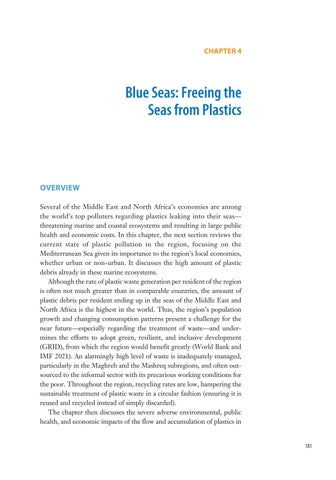CHAPTER 4
Blue Seas: Freeing the Seas from Plastics
OVERVIEW Several of the Middle East and North Africa’s economies are among the world’s top polluters regarding plastics leaking into their seas— threatening marine and coastal ecosystems and resulting in large public health and economic costs. In this chapter, the next section reviews the current state of plastic pollution in the region, focusing on the Mediterranean Sea given its importance to the region’s local economies, whether urban or non-urban. It discusses the high amount of plastic debris already in these marine ecosystems. Although the rate of plastic waste generation per resident of the region is often not much greater than in comparable countries, the amount of plastic debris per resident ending up in the seas of the Middle East and North Africa is the highest in the world. Thus, the region’s population growth and changing consumption patterns present a challenge for the near future—especially regarding the treatment of waste—and undermines the efforts to adopt green, resilient, and inclusive development (GRID), from which the region would benefit greatly (World Bank and IMF 2021). An alarmingly high level of waste is inadequately managed, particularly in the Maghreb and the Mashreq subregions, and often outsourced to the informal sector with its precarious working conditions for the poor. Throughout the region, recycling rates are low, hampering the sustainable treatment of plastic waste in a circular fashion (ensuring it is reused and recycled instead of simply discarded). The chapter then discusses the severe adverse environmental, public health, and economic impacts of the flow and accumulation of plastics in
181






